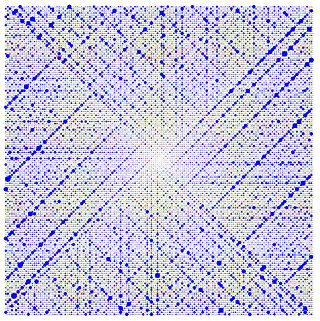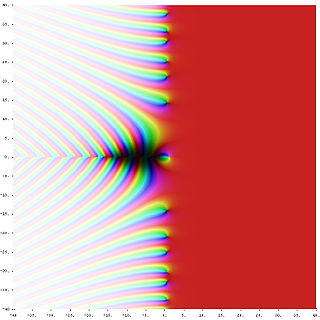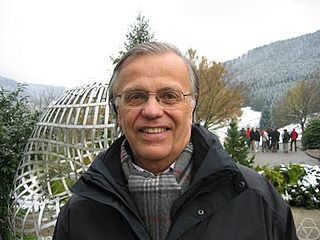Contents
- Before 1000 BCE
- About 300 BCE
- 1st millennium AD
- 1000–1500
- 17th century
- 18th century
- 19th century
- 20th century
- 21st century
- References
A timeline of number theory .
A timeline of number theory .

In mathematics, a conjecture is a conclusion or a proposition that is proffered on a tentative basis without proof. Some conjectures, such as the Riemann hypothesis or Fermat's Last Theorem, have shaped much of mathematical history as new areas of mathematics are developed in order to prove them.

Diophantus of Alexandria was a Greek mathematician, who was the author of a series of books called Arithmetica, many of which deal with solving algebraic equations.

Number theory is a branch of pure mathematics devoted primarily to the study of the integers and arithmetic functions. German mathematician Carl Friedrich Gauss (1777–1855) said, "Mathematics is the queen of the sciences—and number theory is the queen of mathematics." Number theorists study prime numbers as well as the properties of mathematical objects constructed from integers, or defined as generalizations of the integers.

Goldbach's conjecture is one of the oldest and best-known unsolved problems in number theory and all of mathematics. It states that every even natural number greater than 2 is the sum of two prime numbers.

In number theory, Goldbach's weak conjecture, also known as the odd Goldbach conjecture, the ternary Goldbach problem, or the 3-primes problem, states that
The modularity theorem states that elliptic curves over the field of rational numbers are related to modular forms. Andrew Wiles proved the modularity theorem for semistable elliptic curves, which was enough to imply Fermat's Last Theorem. Later, a series of papers by Wiles's former students Brian Conrad, Fred Diamond and Richard Taylor, culminating in a joint paper with Christophe Breuil, extended Wiles's techniques to prove the full modularity theorem in 2001.

Algebraic number theory is a branch of number theory that uses the techniques of abstract algebra to study the integers, rational numbers, and their generalizations. Number-theoretic questions are expressed in terms of properties of algebraic objects such as algebraic number fields and their rings of integers, finite fields, and function fields. These properties, such as whether a ring admits unique factorization, the behavior of ideals, and the Galois groups of fields, can resolve questions of primary importance in number theory, like the existence of solutions to Diophantine equations.

In mathematics, analytic number theory is a branch of number theory that uses methods from mathematical analysis to solve problems about the integers. It is often said to have begun with Peter Gustav Lejeune Dirichlet's 1837 introduction of Dirichlet L-functions to give the first proof of Dirichlet's theorem on arithmetic progressions. It is well known for its results on prime numbers and additive number theory.
In algebra, the Brahmagupta–Fibonacci identity expresses the product of two sums of two squares as a sum of two squares in two different ways. Hence the set of all sums of two squares is closed under multiplication. Specifically, the identity says
Vorlesungen über Zahlentheorie is the name of several different textbooks of number theory. The best known was written by Peter Gustav Lejeune Dirichlet and Richard Dedekind, and published in 1863. Others were written by Leopold Kronecker, Edmund Landau, and Helmut Hasse. They all cover elementary number theory, Dirichlet's theorem, quadratic fields and forms, and sometimes more advanced topics.

Gerhard Frey is a German mathematician, known for his work in number theory. Following an original idea of Hellegouarch, he developed the notion of Frey–Hellegouarch curves, a construction of an elliptic curve from a purported solution to the Fermat equation, that is central to Wiles's proof of Fermat's Last Theorem.
In additive number theory, Fermat's theorem on sums of two squares states that an odd prime p can be expressed as:

A modular elliptic curve is an elliptic curve E that admits a parametrisation X0(N) → E by a modular curve. This is not the same as a modular curve that happens to be an elliptic curve, something that could be called an elliptic modular curve. The modularity theorem, also known as the Taniyama–Shimura conjecture, asserts that every elliptic curve defined over the rational numbers is modular.
In mathematics, a Frey curve or Frey–Hellegouarch curve is the elliptic curve

In number theory, Fermat's Last Theorem states that no three positive integers a, b, and c satisfy the equation an + bn = cn for any integer value of n greater than 2. The cases n = 1 and n = 2 have been known since antiquity to have infinitely many solutions.
This is a timeline of pure and applied mathematics history. It is divided here into three stages, corresponding to stages in the development of mathematical notation: a "rhetorical" stage in which calculations are described purely by words, a "syncopated" stage in which quantities and common algebraic operations are beginning to be represented by symbolic abbreviations, and finally a "symbolic" stage, in which comprehensive notational systems for formulas are the norm.
Fermat's Last Theorem is a theorem in number theory, originally stated by Pierre de Fermat in 1637 and proven by Andrew Wiles in 1995. The statement of the theorem involves an integer exponent n larger than 2. In the centuries following the initial statement of the result and before its general proof, various proofs were devised for particular values of the exponent n. Several of these proofs are described below, including Fermat's proof in the case n = 4, which is an early example of the method of infinite descent.

Fermat's right triangle theorem is a non-existence proof in number theory, published in 1670 among the works of Pierre de Fermat, soon after his death. It is the only complete proof given by Fermat. It has several equivalent formulations, one of which was stated in 1225 by Fibonacci. In its geometric forms, it states: